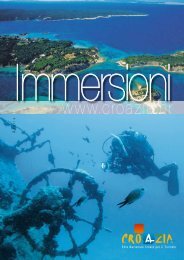Diving
Diving
Diving
You also want an ePaper? Increase the reach of your titles
YUMPU automatically turns print PDFs into web optimized ePapers that Google loves.
ŠIBENIK<br />
The Kornati area is virtually inexhaustible in its variety of locations offering<br />
quite specific types of underwater relief: steep walls teeming with life,<br />
underwater caves, crevices and passages covering a large area of<br />
northern Dalmatia. <strong>Diving</strong> centres located on the mainland charge higher<br />
costs for accessing diving locations, but their position ensures that they<br />
also attract a greater number of divers.<br />
Starting from the Šibenik area, where the Kornati archipelago teems with<br />
many diverse varieties of marine life and is so easily accessible to diving<br />
centres situated along the main belt on land (Vodice, Murter, Šibenik<br />
Primošten), and all the way to the area of the large islands of central<br />
Dalmatia, this zone represents a true threshold to the Adriatic: the open<br />
sea from the southwest cleanses the aquatorium so rich in fish, and<br />
the essential nature of the navigational routes dating from the times of<br />
Antiquity and the Middle Ages down to this day clearly demonstrate that<br />
this has been a scene of intense human activity since times immemorial.<br />
Apart from numerous smaller archaeological sites (Kornati, Lavsda, Žirje,<br />
Smokvica, Muljica) and the variety of geological formations to be found<br />
in the southern Kornati belt, and the karstic land massif, this area also<br />
offers a synthesis of the northern and the southern underwater worlds of<br />
the Adriatic Sea: clear seas, with cliffs and sunken reefs, caves and deep<br />
depressions concealing many still undiscovered wrecks. It is no wonder<br />
that new locations (wrecks) are being discovered from time to time, and<br />
the area is still mostly un-researched. A specific aspect of the under<br />
researched regions of the submarine world lies in the fact that during<br />
the times of the former Yugoslavia and the activities which the one-time<br />
Yugoslav National Army concentrated in this area, diving was prohibited<br />
due to the strategic and military systems (Žirje – Zečevo – Smokvica<br />
– Cape Ploča). The southern coast of the island of Žirje is particularly<br />
interesting and attractive since it resembles other islands of the outer belt<br />
– where one location ends another begins, which makes diving in these<br />
waters a truly exciting experience.<br />
One of the most significant wrecks in this area is the Francesca da<br />
Rimini, which lies immediately off the northern coast of the island of<br />
Kaprije. The ship was sunk on March 22, 1944, when two RAF Spitfires<br />
launched their aerial torpedoes, which struck the vessel while it was at<br />
anchor and camouflaged. This is a very well preserved WW2 iron ship,<br />
42 m long, a beam of 12 m and with three masts, which, before the<br />
war, was owned by a Croatian shipping company. With the onset of war<br />
the vessel was commandeered by the Italians who used it to transport<br />
armaments. When Italy capitulated in 1943, the ship was taken over by<br />
the Germans, who used for the same purpose right up until the day it was<br />
sunk by allied aircraft.<br />
Not far from this site, along the northern cape of the island of Kaprije,<br />
there are underwater cascades which are undoubtedly among the most<br />
beautiful locations of underwater walls in this part of the Adriatic – they<br />
begin at a depth of 20 m and descend to a depth of 50 m.<br />
∆ Preparing to enter the deep blue of<br />
the Adriatic Sea<br />
Diver investigating the wreck of a<br />
steamboat near Primošten<br />
∆<br />
Croatian National Tourist Board 29




